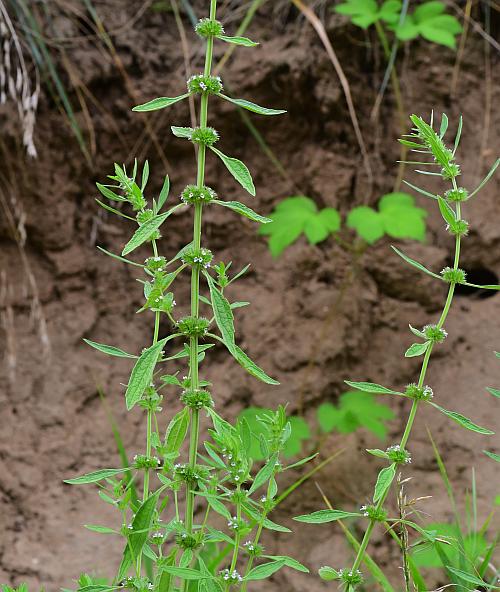Leonurus marrubiastrum L.
Horehound Motherwort

Introduced
CC = *
CW = 5
MOC = 7
© SRTurner
Leonurus marrubiastrum L.Horehound Motherwort | |
 |
Introduced CC = * CW = 5 MOC = 7 |
© SRTurner |
|
Family - Lamiaceae Habit - Taprooted biennial forb. Stem - Ascending to erect, to 1.0 m, 4-angled, usually branched, moderately to densely pubescent with short, fine, downward-angled hairs.
Leaves - Opposite, simple, petiolate. Blades 1-9 cm long, all unlobed, those of the lower leaves ovate to broadly ovate in outline, grading into those of the median and upper leaves, which are lanceolate to elliptic or narrowly elliptic in outline, the margins with coarse, sharp teeth, broadly rounded to angled (lower leaves) or narrowly angled to tapered (upper leaves) at the base, angled or tapered to a bluntly or sharply pointed tip, the upper surface sparsely to moderately pubescent with short, fine, appressed hairs, the undersurface densely pubescent with fine, loosely appressed hairs, sometimes also with sparse longer hairs, densely dotted with conspicuous sessile glands, the venation strongly expressed.
Inflorescences - Dense axillary clusters of numerous flowers per node, these sessile or nearly so. Bractlets shorter than to about as long as the calyces, linear, often spinescent at the tips.
Flowers - Calyces nearly actinomorphic, 4-7 mm long, 5-lobed, finely 10-nerved, the nerves not thickened or riblike, the teeth about as long as the tube, densely and minutely hairy, also with numerous sessile glands. Corollas zygomorphic, bilabiate, 4-7 mm long, slightly shorter than to about as long as the calyces, white, pale pink, or lavender (the lower lip usually with reddish purple spots or mottling), the upper lip broadly rounded and entire, the lower lip 3-lobed and spreading, sparsely to moderately short-hairy externally, the upper lip densely pubescent with similar, fine, loosely appressed hairs. Stamens 4, not exserted (the upper pair curved under the upper lip, the lower pair with the anthers positioned just above the corolla throat), the filaments of 2 lengths, the anthers small, the connective somewhat expanded, the pollen sacs 2, dark purple, usually spreading. Ovary shallowly lobed, the style not exserted, with 2, short, equal or unequal branches at the tip.
Fruits - Nutlets 1.5-2.5 mm long, broadly rounded at the tip. Flowering - July - October. Habitat - Bottomland forests, streambanks, barnyards, roadsides, disturbed areas. Origin - Native to Africa and Eurasia. Lookalikes - Marrubium vulgare, species of Lycopus and Leonurus. Other info. - This species was first reported in Missouri from Holt County, in 1986. At present it is still widely scattered and fairly rare. Beyond Missouri, occurrences are sporadic and largely confined to a band across the upper Midwest. The plant is identified by its opposite, toothed leaves and dense axillary inflorescences, although this description also applies to its lookalikes. In particular, Marrubium vulgare, which is somewhat more common, appears very similar. However, the calyces of that species have ten teeth instead of five. When bruised, foliage of Leonurus marrubiastrum emits a faint but pleasant aroma. Photographs taken along Fox Creek, St. Louis County, MO, 7-29-2020 (SRTurner). |